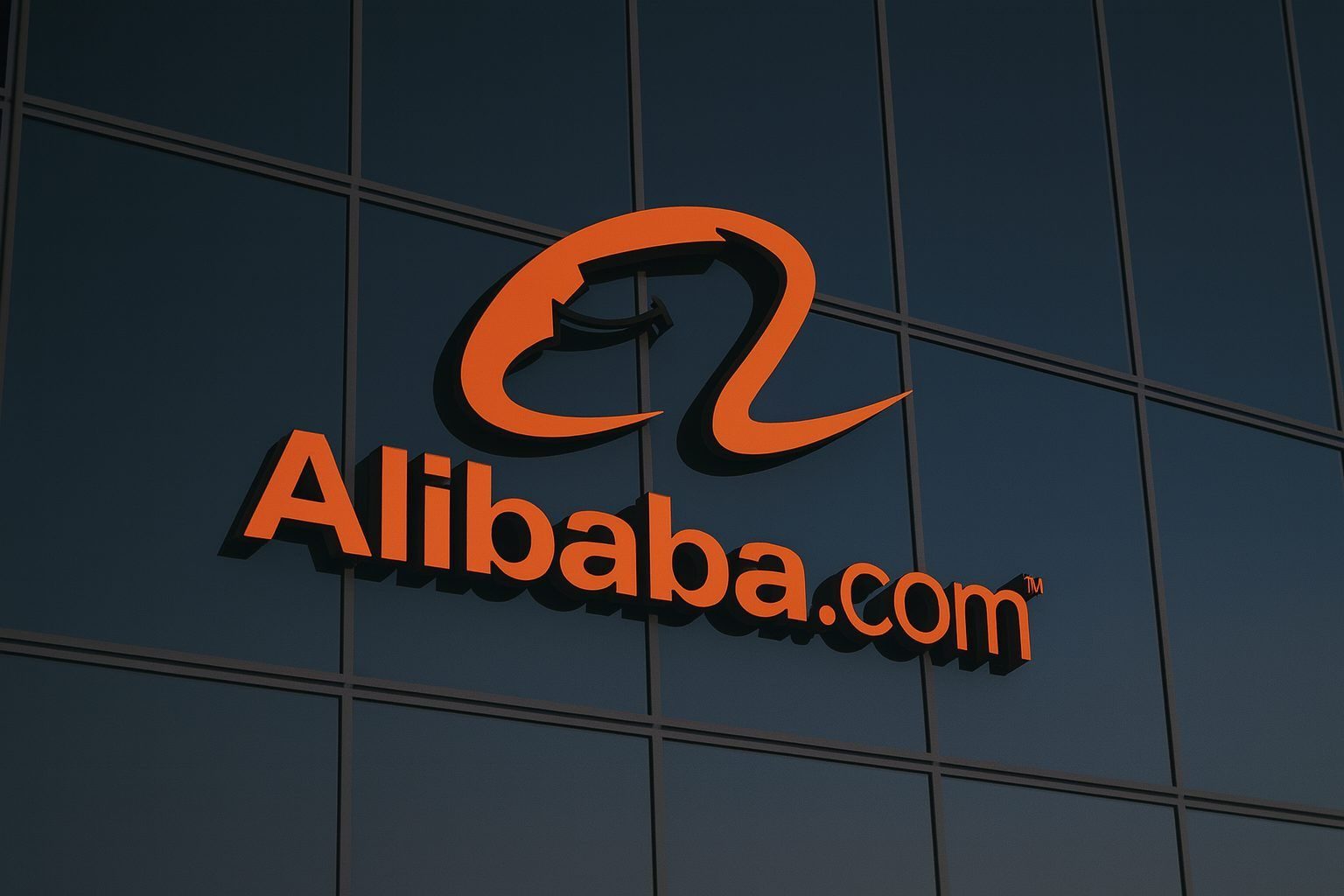Key Takeaways
- Alibaba stock is modestly higher today: Around midday on Wednesday, November 26, 2025, Alibaba Group Holding Limited (NYSE: BABA) is trading near $158.90, up about 1.2% from yesterday’s close at $157.01 after a sharp post‑earnings drop. [1]
- Q2 FY2026 earnings were mixed: Revenue for the quarter ended September 30, 2025 rose 5% year‑on‑year to RMB 247.8 billion (≈$34.8 billion) and would have grown about 15% excluding disposed retail assets, but operating income fell 85%, and non‑GAAP net income plunged 72%. [2]
- AI + Cloud is the growth engine: Cloud revenue jumped 34% to RMB 39.8 billion, driven by booming demand for AI services, with AI‑related product revenue growing at triple‑digit rates for the ninth straight quarter. [3]
- Heavy spending is crushing cash flow: Operating cash flow dropped roughly 68% year‑on‑year to RMB 10.1 billion, and free cash flow swung to an outflow of RMB 21.8 billion, reflecting massive capex for AI infrastructure and “quick commerce.” [4]
- Wall Street mostly stays bullish but trims targets: JPMorgan, Barclays, Bank of America, Bernstein and Benchmark all maintain Buy/Overweight stances with price targets in the $188–$230 range, while consensus targets cluster around the mid‑$190s, implying ~20–25% upside from current levels. [5]
- Regulatory and ESG risks remain in focus: AliExpress has banned a China‑based seller of childlike sex dolls after a Reuters investigation, with the EU saying it is closely monitoring the platform’s compliance under the Digital Services Act (DSA). [6]
Alibaba (BABA) Stock Price Today
As of early afternoon trading in New York on November 26, 2025, Alibaba’s U.S.‑listed ADRs are changing hands at roughly $158.90, up about $1.90 (≈1.2%) on the day. [7]
Key intraday stats: [8]
- Day’s range: about $156.9 – $161.4
- Previous close:$157.01
- Volume: ~9.2 million shares so far vs. a 3‑month average near 19.9 million
- 52‑week range:$80.06 – $192.67
- 1‑year change: roughly +83%
By most metrics, Alibaba is now a large‑cap growth stock with:
- Market cap in the mid‑$300 billion range
- P/E ratio around 18–19x
- Price‑to‑book near 2.5x
- Beta well below 1 (≈0.3), reflecting lower correlation with broader U.S. tech. [9]
Yesterday’s session (November 25) was volatile: BABA finished down 2.31% at $157.01 after swinging more than 6% intraday as investors digested the earnings release. Technical research site StockInvest notes that the stock has fallen in 6 of the last 10 sessions, remains in a wide but rising short‑term trend, and shows medium volatility. [10]
Q2 FY2026 Earnings: Revenue Beat, Profit Collapse
Alibaba’s latest quarter, reported on November 25, 2025, is the core driver of today’s price action and news coverage. [11]
Top line: Solid growth, stronger than it looks
For the quarter ended September 30, 2025 (Alibaba’s Q2 FY2026):
- Revenue:RMB 247.8 billion (≈$34.8 billion), +5% year‑on‑year
- Like‑for‑like revenue (excluding Sun Art & Intime disposals):+15%
- Cloud Intelligence Group revenue:RMB 39.8 billion, +34% year‑on‑year, accelerating from ~26% in the prior quarter. [12]
Growth was largely powered by:
- AI cloud adoption – AI‑related cloud revenue grew at triple‑digit rates for the ninth consecutive quarter, with strong demand from enterprise customers. [13]
- China e‑commerce monetization – customer management revenue (ad + merchant services) grew 10% to nearly RMB 79 billion, driven by better take rates and higher engagement on Taobao. [14]
- International commerce – Alibaba’s overseas platforms, including AliExpress and other international retail/wholesale units, grew revenue by about 10% and delivered a small adjusted EBITA profit. [15]
Bottom line: Operating income and EPS under pressure
Strong revenue did not translate into strong profit:
- Income from operations:
- Fell from RMB 35.2 billion to RMB 5.4 billion (≈$754 million)
- Operating margin shrank from 15% to 2% (‑13 percentage points). [16]
- Net income (GAAP):
- RMB 20.6 billion (≈$2.9 billion), down 53% year‑on‑year
- Net income attributable to ordinary shareholders:RMB 21.0 billion, down 52%. [17]
- Non‑GAAP metrics:
Several analyst notes today highlight that while revenue modestly beat expectations, EPS missed most Street estimates — one reason BABA initially sold off despite strong AI headlines. [20]
AI + Cloud and Quick Commerce: High-Growth, High-Spend Strategy
Alibaba’s management is explicit: this is an investment phase focused on AI + Cloud and “quick commerce” (30‑minute delivery) rather than maximizing near‑term profit. [21]
AI and Cloud: Building a national champion
Highlights from the company release and earnings commentary: [22]
- Cloud Intelligence Group revenue rose 34% to RMB 39.8 billion, with external customer revenue up 29%, beating many expectations.
- AI‑related products delivered triple‑digit revenue growth again, supported by:
- Strong uptake of Alibaba’s Qwen AI models
- Growing use of AI coding assistants and industry‑specific solutions
- At the Apsara Conference, Alibaba Cloud announced a major upgrade to its full‑stack AI infrastructure, including servers, networking, storage, and model‑training platforms.
- According to market research cited by Alibaba, the company holds roughly 36% share of China’s AI cloud market, ahead of domestic rivals. [23]
The consumer‑facing Qwen app — a ChatGPT‑style product powered by Alibaba’s models — has become a symbol of this push. Launched shortly before the quarter’s end, it surpassed 10 million downloads in its first week, an achievement highlighted in multiple coverage pieces today. [24]
On today’s AI narrative:
- CEO Eddie Wu reiterated that he does not see an “AI bubble,” arguing that AI compute will remain undersupplied for at least the next three years as real‑world adoption spreads across product development, manufacturing and corporate functions. [25]
- Management has already spent around RMB 120 billion on AI and cloud infrastructure over the past four quarters and has a previously announced RMB 380 billion (≈$53 billion) AI capex plan for the next three years — which Wu now says “might be on the small side.” [26]
Quick commerce: Growth at the cost of margins
Alibaba is also leaning heavily into 30‑minute delivery and instant commerce as a strategic pillar of its China retail business: [27]
- Quick commerce revenue surged around 60% year‑on‑year in Q2, up from low‑teens growth in the prior quarter.
- Management has onboarded thousands of Tmall brand offline stores and set an ambitious target of RMB 1 trillion in GMV within three years.
- Per‑order losses in quick commerce have reportedly been cut by roughly half since mid‑2025 as logistics efficiency and average order values improve.
CFO Toby Xu acknowledged in the earnings call that this strategy is hammering cash flow, but framed it as reinvesting free cash flow to “create a winning quick commerce business and be a leader in AI.” [28]
Cash Flow Squeeze: Free Cash Flow Turns Deeply Negative
The most worrying line item for many investors is cash flow:
- Net cash from operating activities:RMB 10.1 billion (≈$1.4 billion), down ≈68% from a year ago.
- Free cash flow:outflow of RMB 21.8 billion (≈$3.1 billion) vs. an inflow of RMB 13.7 billion in the same quarter of 2024. [29]
- Over the first six months of FY2026, free cash flow swung from a RMB 31.1 billion inflow last year to a RMB 40.7 billion outflow this year, largely due to AI and cloud capex plus quick commerce investments. [30]
Benzinga’s coverage today underscores this point, noting that Alibaba’s operating cash flow roughly halved in dollar terms year‑on‑year and that management explicitly tied the drop to “strategic” spending in AI and quick commerce. [31]
The good news: Alibaba still sits on RMB 573.9 billion (≈$80.6 billion) in cash and liquid investments, giving it a substantial buffer to fund this capex cycle. [32]
Analyst Reaction Today: Targets Lowered, Ratings Mostly Positive
Street targets cluster in the high‑$100s
A flurry of analyst notes on November 26 shows a broadly constructive but more cautious Wall Street stance:
- JPMorgan (Alex Yao) – Maintains Overweight, but cuts price target from $240 to $230, citing near‑term earnings pressure but long‑term AI opportunity. [33]
- Barclays – Raises target from $190 to $195, keeps Overweight after reviewing the Q2 print and the acceleration in cloud growth. [34]
- Bernstein (Robin Zhu) – Keeps Outperform, trims target from $200 to $190, arguing that heavier AI investment justifies slightly lower near‑term earnings but supports the structural thesis. [35]
- Bank of America (Joyce Ju) – Reiterates Buy with a $188 target, flagging the 34% cloud growth, 10% customer management revenue growth and 60% quick commerce growth as supportive of long‑term earnings power. [36]
- Benchmark – Reaffirms Buy and a $195 target, describing Alibaba as undervalued with about 24% upside from the pre‑earnings price. [37]
Across various data providers, consensus metrics today look roughly like this:
- Average/mean price target: around $190–$197, implying 20–25% upside vs. ~$159. [38]
- Street‑high target: about $240, implying roughly 50% upside if bullish scenarios play out. [39]
- Consensus rating: in the Buy to Strong Buy range, with MarketBeat citing 18 Buy‑equivalent ratings, one Sell, and one Strong Buy, for an overall “Moderate Buy.” [40]
TipRanks’ AI‑generated note today highlights that Bank of America’s Buy thesis rests on AI‑driven cloud growth, improving quick commerce unit economics and resilient customer‑management revenue, while also mentioning that Barclays maintains a Buy with a $195 target. [41]
Diverging views: Is BABA cheap or already priced for AI?
Not everyone agrees on valuation:
- A Barchart piece this morning describes Alibaba’s adjusted EBITDA collapse as “whopping” but argues the stock is still a buy‑the‑dip AI leader, noting a forward P/E near 26x and a mean target price of $195.29—about 23% above current levels. [42]
- One Seeking Alpha analyst writes that “the market got its earnings wrong,” emphasizing that headline EPS and free‑cash‑flow weakness largely reflect disposals and front‑loaded AI capex, while like‑for‑like revenue and AI moat are strengthening; that piece suggests up to ~68% upside in a successful execution scenario. [43]
- Another author on the same platform, in a separate article today, reportedly views Alibaba as too expensive on AI tailwinds and prefers Meta Platforms instead, underscoring that some investors see the recent rerating as stretched relative to risk. [44]
In short, most sell‑side brokers remain optimistic, while some independent analysts warn that AI euphoria and China risk could be under‑priced.
Institutional Flows and Share Buybacks
On the institutional side, Himension Capital Singapore PTE. LTD. disclosed a new position of 18,200 BABA shares worth about $2.06 million, according to a fresh 13F‑based note published today. The same report lists a string of smaller new positions from other advisors and pegs institutional and hedge‑fund ownership around 13.5% of the float. [45]
Meanwhile, Alibaba continues to support its stock with buybacks:
- In the September quarter, the company repurchased 17 million ordinary shares (roughly 2 million ADSs) for $253 million, leaving $19.1 billion authorized under its repurchase program through March 2027. [46]
Regulatory Spotlight: AliExpress and the EU’s Digital Services Act
Regulation is back in the headlines today after Reuters reported that AliExpress, Alibaba’s international marketplace, permanently banned a China‑based seller of childlike sex dolls following a Reuters examination of whether the listings complied with European and U.S. laws. [47]
Key points from that report: [48]
- Reuters alerted AliExpress to several listings earlier in November; the company initially removed them as a precaution.
- After further investigation, AliExpress said it decided to “permanently close down” the seller’s account, citing dishonesty about its activities.
- The European Commission stated it is “carefully monitoring AliExpress’ compliance” with the Digital Services Act (DSA), which imposes strict obligations on large online platforms around illegal and harmful content.
- EU lawmakers this week backed a resolution urging stronger enforcement against non‑compliant platforms, specifically mentioning childlike sex dolls alongside weapons and other illegal products.
For investors, the episode is a reminder that Alibaba’s global platforms face heightened regulatory, legal and reputational risks, especially in Europe, even as they drive incremental growth.
Technical Picture: Trend, Support and Near-Term Trading Range
Technical analysis from StockInvest, updated for Tuesday’s close and looking ahead to today’s session, notes: [49]
- BABA has declined 2.31% to $157.01 in the last session, with a daily high‑low swing of about 6.5%.
- The stock is sitting in the middle of a wide, rising short‑term trend, with a modelled 12% potential gain over the next three months under its base scenario.
- Important short‑term support is flagged around $155–$156, with resistance near $165–$166.
- The service currently labels BABA as a “sell candidate” based purely on moving‑average and MACD signals, and highlights medium daily volatility.
Technical opinions can differ widely, but these levels give a sense of where traders are watching for breakouts or breakdowns in the coming days.
Macro Backdrop: Fed Cut Bets and China Sentiment
Alibaba’s latest moves come against a broader backdrop of improving risk appetite:
- Asian equities extended their rally today as Fed rate‑cut expectations intensified following weak U.S. consumer data and softer retail sales, with the 10‑year Treasury yield dipping below 4%. [50]
- Chinese stocks are in focus as Alibaba’s U.S. shares fell after earnings, but the broader narrative is that investors are returning to Chinese tech as Beijing has moderated its regulatory crackdown and is actively courting private‑sector growth. [51]
This macro environment tends to favor long‑duration growth stories like AI infrastructure, but it can also amplify volatility if rate expectations or geopolitical sentiment shift.
What to Watch Next for Alibaba Stock
For readers tracking Alibaba stock (BABA) after today’s news flow, several themes look critical over the coming quarters:
- Trajectory of AI and cloud growth
- Can Alibaba sustain 30%+ cloud growth while gradually rebuilding margins, or will competition and capex keep profitability depressed longer than the market expects? [52]
- Quick commerce losses vs. user growth
- Management says this quarter may represent peak investment in instant commerce, with per‑order losses already halved. Investors will be watching whether losses shrink further without sacrificing growth or market share. [53]
- Free cash flow normalization
- With free cash flow deeply negative, a key question is when — and how fast — FCF can swing back to positive territory as AI and logistics capex moderates. [54]
- Regulatory developments in China and the EU
- Any new actions under China’s tech regulation framework or Europe’s DSA could affect growth, margins and required compliance spending, especially for AliExpress and other cross‑border platforms. [55]
- Valuation vs. execution risk
- With BABA up more than 80% over the past year and trading at a high‑teens to mid‑20s earnings multiple depending on the metric, the stock now prices in a significant degree of AI‑driven turnaround. Failure to deliver could lead to sharp de‑risking, while successful execution could justify the bullish targets near and above $200. [56]
Bottom Line
On November 26, 2025, Alibaba sits at the center of two powerful — and conflicting — forces:
- A fast‑growing AI and cloud franchise plus surging quick commerce that is strengthening its strategic moat in China and in enterprise AI globally.
- A dramatic profit and cash‑flow squeeze caused by the very investments meant to secure that future, amid ongoing regulatory scrutiny at home and abroad.
Most major brokers still see upside for BABA stock, but their target tweaks and the heated debate among independent analysts show that execution risk and valuation are back under the microscope.
For now, Alibaba remains one of the most closely watched AI and e‑commerce plays in the world’s second‑largest economy, and today’s modest rebound suggests the market is still willing to give management time — but not a blank check — to turn massive AI and logistics spending into sustainable earnings growth.
Disclaimer: This article is for informational and news purposes only and does not constitute investment advice, financial guidance, or a recommendation to buy or sell any security. Always do your own research and consider consulting a licensed financial professional before making investment decisions.
References
1. www.investing.com, 2. www.businesswire.com, 3. www.businesswire.com, 4. www.businesswire.com, 5. www.gurufocus.com, 6. www.investing.com, 7. www.investing.com, 8. www.investing.com, 9. www.investing.com, 10. stockinvest.us, 11. www.businesswire.com, 12. www.businesswire.com, 13. www.businesswire.com, 14. www.businesswire.com, 15. www.businesswire.com, 16. www.businesswire.com, 17. www.businesswire.com, 18. www.businesswire.com, 19. www.businesswire.com, 20. www.benzinga.com, 21. www.businesswire.com, 22. www.businesswire.com, 23. www.businesswire.com, 24. www.tikr.com, 25. www.indexbox.io, 26. www.businesswire.com, 27. www.businesswire.com, 28. www.benzinga.com, 29. www.businesswire.com, 30. www.businesswire.com, 31. www.benzinga.com, 32. www.businesswire.com, 33. www.gurufocus.com, 34. www.gurufocus.com, 35. www.benzinga.com, 36. www.tipranks.com, 37. www.investing.com, 38. www.investing.com, 39. markets.financialcontent.com, 40. www.marketbeat.com, 41. www.tipranks.com, 42. markets.financialcontent.com, 43. seekingalpha.com, 44. seekingalpha.com, 45. www.marketbeat.com, 46. www.businesswire.com, 47. www.investing.com, 48. www.investing.com, 49. stockinvest.us, 50. www.moneycontrol.com, 51. www.moneycontrol.com, 52. www.businesswire.com, 53. www.tikr.com, 54. www.businesswire.com, 55. www.investing.com, 56. www.investing.com







